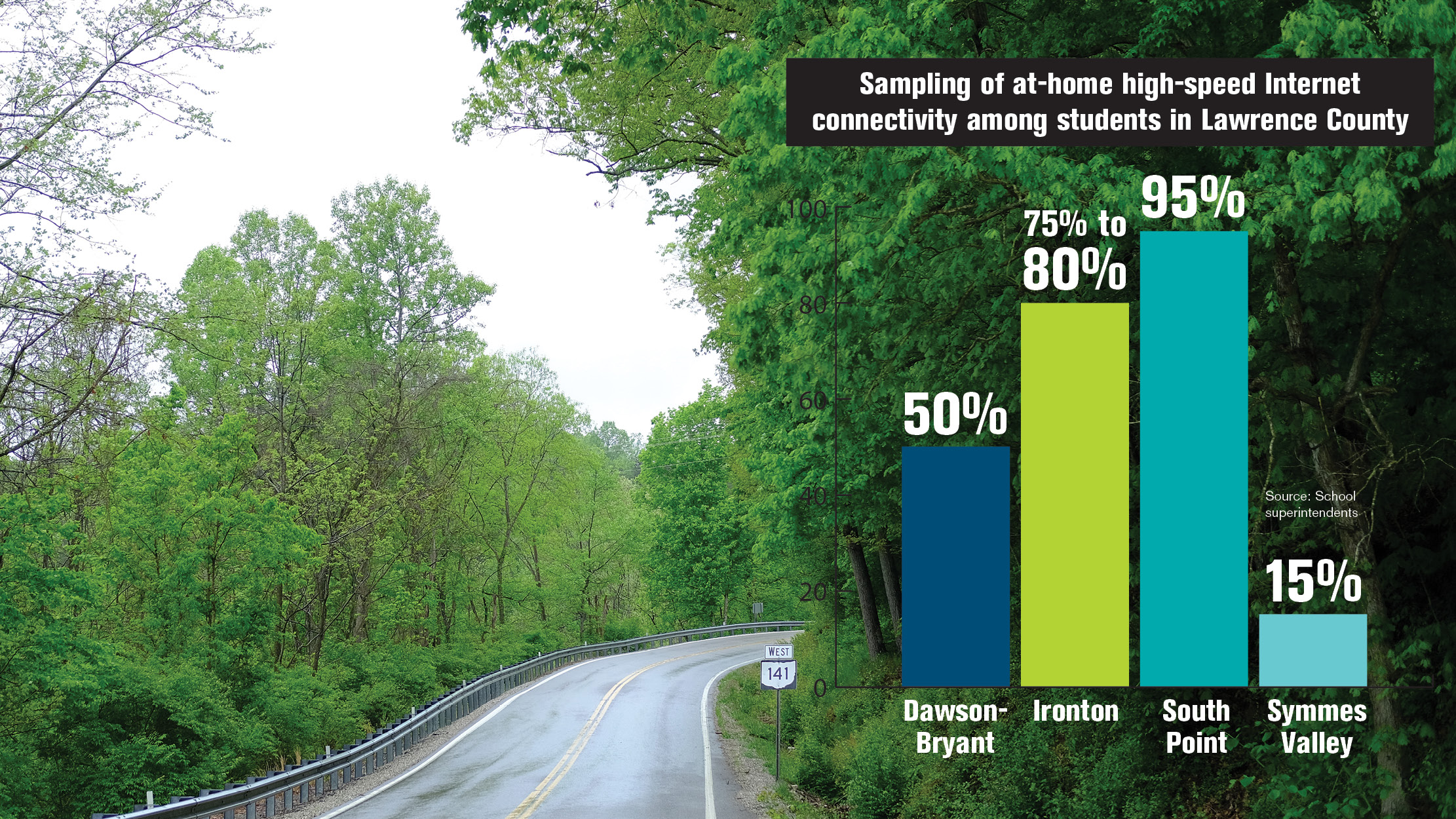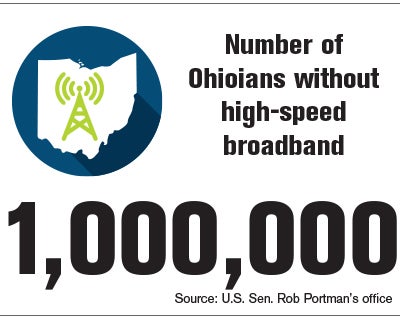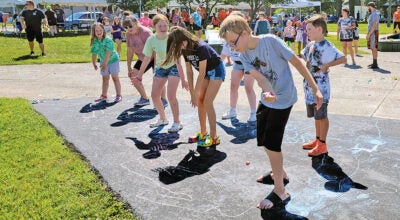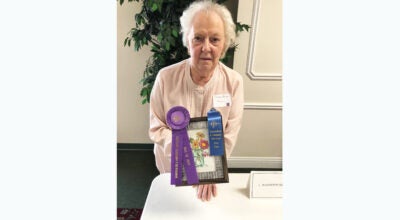Ending the digital divide
Published 5:18 am Saturday, May 23, 2020
Pandemic illustrates need for high-speed broadband in county, rural America
The issue of high-speed broadband access has been a concern in Lawrence County and rural parts of the nation for some time and, with the COVID-19 pandemic, the need for connectivity has only become more apparent.
Ohio Gov. Mike DeWine ordered Ohio K-12 schools closed in March due to the coronavirus threat and students began the switch to remote learning. Similarly, colleges and universities throughout the county also ended in-person learning and went to remote classes.
DeWine said he envisions that when Ohio schools resume in the fall, they will be utilizing a hybrid system of in-person and remote learning.
Disparities in the county
Symmes Valley Superintendent Darrell Humphreys said the move to remote learning is difficult for his district, where reliable broadband service is nearly non-existent.
Humphreys estimates that only 15 percent of the district’s students have fast Internet service at home, capable of streaming class lessons, that would be conducive to remote learning via computer.
The problem is compounded by a lack of cell service in the area, which could serve as an alternate means for students to receive online instruction, with most cell phones becoming useless a few miles out of Ironton on State Route 141.
“There’s a hill here I call ‘the phone booth,’” Humphreys said, referring to the one high spot on the road where a signal can be picked up. He says it is not uncommon to see cars pulled off at that spot to make calls.
The district itself has attempted to make strides into the digital age and, a few years ago, purchased laptops for every student, which can be taken home to do assignments. However, with no or severely limited Internet service at home, the problem remains.
“Something has to be done,” Humphreys said of his district, which is geographically the largest in the county, covering more square miles than the county’s other school districts combined. “These kids aren’t getting the same opportunities as other districts or parts of the country.”
He said the problem with broadband and cell service is nearly the same in the neighboring Rock Hill school district, which covers the rural areas along State Route 93 north of Ironton.
In the Dawson-Bryant school district, which represents Coal Grove and surrounding areas, superintendent Steve Easterling said he estimates about 50 percent of students have access to have high-speed broadband.
“It’s either not available or the families can’t afford it,” Easterling said, acknowledging that remote learning will be a challenge for the district, should it be required in the fall.
For this last semester, Symmes Valley implemented its remote learning by sending home hard packets of worksheets to students.
Some districts in the county, which aren’t as rural, are working with a better digital infrastructure.
In the county’s lone city, Ironton City Schools superintendent Joe Geletka said that the issue affects about 1 in 4 students.
“We estimate approximately 75-80 percent of students have access to the Internet,” he said.
South Point superintendent Mark Christian said about 95 percent of students there have access to high-speed broadband.
“I had my tech guy look at it recently,” he said. “We’re in good shape. But we have a few in the outer areas.”
Christian said, for those students, the schools are using hard packets for remote learning.
Lawrence County Commissioner Deanna Holliday said she has heard from some constituents about the need.
“We are aware of the problem for the area,” she said.
She said the commission has been reaching out to local school districts.
“We’re finding out how they have been impacted, in day-to-day business, ” she said.
She said the pandemic has shed a light on the issue in the county, with local government seeing the issue firsthand when personnel had to work from
home.
“We have got to get into the 21st century and get our technology up to standards,” Holliday said.
A national problem
The problem of disparities in services is not unique to Lawrence County or Ohio.
According to a 2019 study by the Federal Communications Commission, 21 million Americans lack connection to high-speed, reliable Internet service, defined by the agency as “download speeds of at least 25 megabits per second and upload speeds of at least 3 megabits per second.”
According to the FCC, the issue impacts 30 percent of rural Americans, while 40 percent of the nation’s schools are lacking in high-speed service and 60 percent of health care facilities outside metropolitan areas are facing the same challenge.
A 2017 study by the FCC found that more than a quarter of rural Americans lacked high-speed service and broke the numbers down by state. In Ohio, 94.7 of the residents overall were connected, but, in rural areas, the number fell to 78.4 percent.
The lack of competition could also be a factor in the lag in development of service and the urban-rural digital divide. The 2017 FCC study found that in rural areas of the U.S., only 23.1 percent of rural Americans had the option of choosing from a second Internet provider, while only 6.1 percent had a choice of three or more providers.
Officials focus on issue
Some have said the way the FCC and government agencies determine broadband access paints too rosy of a picture.
One of those is U.S. Rep. Bill Johnson, R-Ohio, whose district covers the rural counties along the Ohio River from Marietta to Lawrence County. He said he constantly hears about the need for better service.
When Johnson met with The Ironton Tribune editorial board in 2018, he raised the issue and the need for improvement with federal mapping systems, pointing out that the FCC uses a Census block methodology, which he said is not accurate for determining the situation in rural areas, where the blocks cover larger geographic areas.
“If there is one broadband provider in the census block, they turn it green and say it’s served, and that’s not true — especially along the Ohio River, where you have little towns up and down,” he explained.
Last year, tech company Microsoft attempted to fill in the gaps in county-by-county maps used by the FCC and, according to their internal data they compiled, only 31 percent of Lawrence County residents have high-speed Internet service at home.
Johnson spoke with The Ironton Tribune this month and said the pandemic has only exacerbated the need for improved broadband service.
He described the issue as a “double whammy” during COVID-19, with broadband needed, not just for schools, but for those seeking health care.
“We need it from the perspective of telehealth,” he said, stating that many physicians are advising those who are ill not to come into offices and to use remote services. “We’re told that staying at home helps to keep your temperature down.”
Johnson said, as a father, he knows “a lot of school systems are struggling with remote learning.”
“It’s very, very problematic,” he said.
Though he said DeWine, in calling for remote learning, will not forget the need in the region.
“I believe the governor understands how critically important broadband access is to southeast Ohio,” he said.
Johnson said significant federal funds were approved for rural broadband, which were “set to be rolled out next year.”
“I’m encouraging the FCC chair to expedite that,” he said. “And we don’t want to stop there.”
Johnson said mapping remains a major hurdle, and said many providers have not given accurate information to the FCC in mapping.
“We don’t need a map to know which areas are served and underserved,” he said, stating members can find out the severity of the need from talking to local officials.
“Mayors, township trustees, they can tell you where the difficulties are,” he said.
The congressman said there is no single solution” to resolving the issue and that many providers are hesitant to invest in areas where “the nearest neighbor can be five miles away.”
“It’s not cheap,” he said of the costs of cable and other elements. “And it’s difficult to build out there.”
Johnson said the issue has been one of his top priorities in office and legislation he sponsored would be geared toward local governments.
“I introduced, along with Rep. Rod Whitman, the Serving Rural America Act,” he said of the bill put forward last month.
Johnson said it would create a five-year pilot grant program at the FCC, authorizing $100 million a year for a total of $500 million over five years to expand broadband service to areas in need.
Service providers receiving grants would be required to partner with local governments to ensure needs of residents and the input of locals are included. The legislation would prioritize funding to areas without 25 megabits per second service.
Johnson said he is encouraged by movement on the issue and is “optimistic” progress will be made.
He pointed to President Donald Trump bringing up rural broadband in the State of the Union Address and said funding will likely be a part of bipartisan Phase 4
stimulus infrastructure legislation coming out of Congress.
And he said there is some aid for those laid off during the COVID-19 pandemic, pointing to the U.S. Department of Agriculture’s ReConnect program, which would help those who have lost jobs in rural areas connected.
For Ohio, Johnson said he is confident DeWine and Lt. Gov. Husted understand the need and said he “plans to be invested in this as a parent.”
He said one of the biggest motivators in improving service will be educating the public on the benefits of high-speed broadband and the demand becoming overwhelming.
“I’m always amazed how many people say to me ‘I don’t need it,’” he said.
He said the pandemic has shown how key it is, whether used by schools for remote learning, for the health care industry for telehealth, employers for work-from-home arrangements or for businesses to continue operating online.
“I think a lot of eyes have been opened,” he said. “Access to the digital world around us is as important as our elections.”
Sam Mulopulos, a technical policy advisor for U.S. Sen. Rob Portman, R-Ohio, gave The Ironton Tribune some background about the senator’s work on the issue.
In December, Portman urged FCC chairman Ajit Pai to modify the new Rural Digital Opportunity Fund to gear it better toward Appalachia, feeling the existing legislation was too broad.
Portman told Pai that more than one million Ohioans lack access to high-speed service at home.
“Broadband maps often overstate coverage, and a mix of low population density and mountainous terrain make Internet build out expensive,” Portman said in his letter to the FCC. “The losers from this unfortunate combination of policy and topography are our constituents who, in an increasingly internet-enabled society, are being left behind.”
Portman said a solution would be to “structure auction conditions to ensure bidders prioritize deployment to difficult to reach locations.”
“I understand the high cost of serving some of these individuals, but believe they should not be written out of the conversation,” he said.
In December, Portman, partnering with Democratic Sen. Tina Smith, of Minnesota, was able to secure funding for the 2020 fiscal year for their Revitalizing Underdeveloped Rural Areas and Lands (RURAL) Act.
The legislation amended the Internal Revenue Code to ensure cooperative organizations do not lose their tax-exempt status when making use of government grants, contributions, and assistance, including rural broadband grants.
“Without this legislation, many co-ops may miss out on grant income or disaster assistance, hurting our efforts to promote economic development and job creation in these rural areas,” Portman said, stating organizations rely heavily on grants to improve infrastructure.
Tackling the problem
Efforts are underway to improve the situation locally.
Last October, Buckeye Rural Electric Cooperative was awarded a $2.5 million grant from the Appalachian Regional Commission for the purpose of bringing broadband to six counties in southeast Ohio — Lawrence Gallia, Jackson, Meigs, Vinton and Athens.
The funds will pay for the installation of more than 160 miles of fiber, creating a network for underserved regions.
Holliday said the Lawrence County Commission formed a broadband commission two months ago, working with Bill Dingus, of the Lawrence County Economic Development Corporation, with the aim to “position ourselves for when funding becomes available.”
Holliday said the idea is to have “shovel ready projects” planned. She said the work of the group was sidelined by the pandemic’s start, but she believes they will be able to get back to the issue.
“We’ll be set and ready to execute,” she said. “There’s a lot of funding coming down the pike.”
Tom Reid, president of Reid Consulting Group, has been working with the Buckeye Hills Regional Council on the issue of broadband in the Appalachian southeast Ohio, concentrating on 32 Appalachian counties and five rural ones.
Reid’s team’s mapping and engineering plans won $66 million in funding from the NTIA Broadband Technology and Opportunities Program to support a $95 million, 2,000-mile fiber-optic broadband project.
He said the biggest obstacle is the lack of population density.
“In Columbus, you have 1,500 households in a square mile, in a rural area you have 20,” he said. “Lawrence County is down in those kind of numbers, once you get away from the larger municipalities.”
He said this does not present a profit opportunity for providers.
“The cost doesn’t change for those square miles,” he said.
Reid echoed the thoughts of Johnson on mapping issues, stating providers receiving federal funds have overstated coverage in places like Lawrence County.
“It dramatically understates the problem. The FCC gathers information from carriers, but there is no verification,” he said.
He said the 31 percent figure calculated by Microsoft sounds accurate for the area, though the government’s maps would lead one to believe otherwise.
He pulls up the FCC’s maps for Lawrence County and, despite Humphreys’ issues for Symmes Valley students, the map shows Kitts Hill, as well as other rural areas like Getaway are covered.
Reid said efforts have been made to improve the situation, with the Broadband DATA Act, moving mapping from a census block model to a location-based model, but he said the issue would remain “if the FCC continues to just believe what carriers say.”
“There needs to verification and it needs to be a significant process,” he said.
Reid said the FCC had appropriated $70 billion over the past 20 years to providers for improving broadband, but, after the money was spent, aging infrastructure remains.
“We’re still in a situation with ancient copper lines, well over 50 years old — some are 70 years old,” he said. “Where did all that money go?”
He said the results are different from other infrastructure problems where this occurs.
“When you build a highway, there’s waste, fraud and abuse, but, at the end, you can still drive on the highway,” he said.
And he said the infrastructure not being maintained has led to a situation where, “over 50 years, the highway has become a goat path.”
“And we have the equivalent of that in rural America,” he said.








